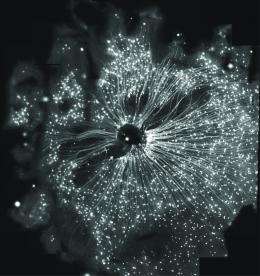Nerve cells live double lives

(PhysOrg.com) -- Scientists at the Friedrich Miescher Institute for Biomedical Research (part of the Novartis Research Foundation) have identified a new neural circuit in the retina responsible for the detection of approaching objects. Surprisingly, however, this is not the only function the circuit fulfills. The same nerve cells are also responsible for night-time vision. This is the first time such a dual function has been demonstrated, shedding new light on the nervous system's information-processing capacity.
In animals and humans, a looming threat triggers the same kind of behavior - freezing followed by flight. The uniform nature of this response suggests that the perception and processing of approaching motion is clearly defined and embedded in the brain.
Scientists working with group leader Botond Roska at the FMI in Basel and at the École Normale Supérieure in Paris have now managed to identify a neural circuit in the retina that responds specifically to approaching objects and conveys this information immediately to the brain.
Nerve cells for detection of approaching objects
As the researchers report in the latest issue of Nature Neuroscience, various types of retinal cells are involved in this perceptual process. An important role is played by the bipolar cells which lie just below the photoreceptors. Two types of bipolar cells are distinguished: those that become active in brighter light (known as ON cells) and those that respond to dimmer light (OFF cells).
For the eye, the image of an approaching object consists of a constantly expanding area of darkness. Therefore, as an object approaches, increasing numbers of OFF bipolar cells respond to this stimulus and transmit this signal to the next layer of retinal cells - the ganglion cells. These integrate the signal and transmit it to the brain. The same system is shut of when faced with laterally moving objects: here the lateral motion activates amacrine cells, another cell type in the retina, which shut down the information flow. Rapid processing of this information is often a matter of life or death - especially in the natural world, when an animal is suddenly confronted with a predator.
Different daytime and night-time functions
But this was not the only new finding. To date, given the vast numbers of nerve cells and the profusion of neural circuits, it has seemed perfectly reasonable to seek to ascribe a single function to a particular type of nerve cell. However, Roska's experiments showed that the nerve cells that detect approaching objects during the day serve a different function during the night: they are then responsible, via other photoreceptors, for night-time vision. Precisely how amacrine cells process these two different kinds of stimuli remains to be fully elucidated. Also unresolved is the question of what happens in the retina when the two different types of perception coincide - for example, when an owl swoops on a mouse at night-time. The results do, however, demonstrate that the capacity of the nervous system to process information is increased many times over when different types of nerve cells are involved in multiple perceptions.
More information: Münch TA et al. (2009) Approach sensitivity in the retina processed by a multifunctional neural circuit. Nature Neuroscience, 12, 1308-1316.
Provided by Friedrich Miescher Institute for Biomedical Research
















